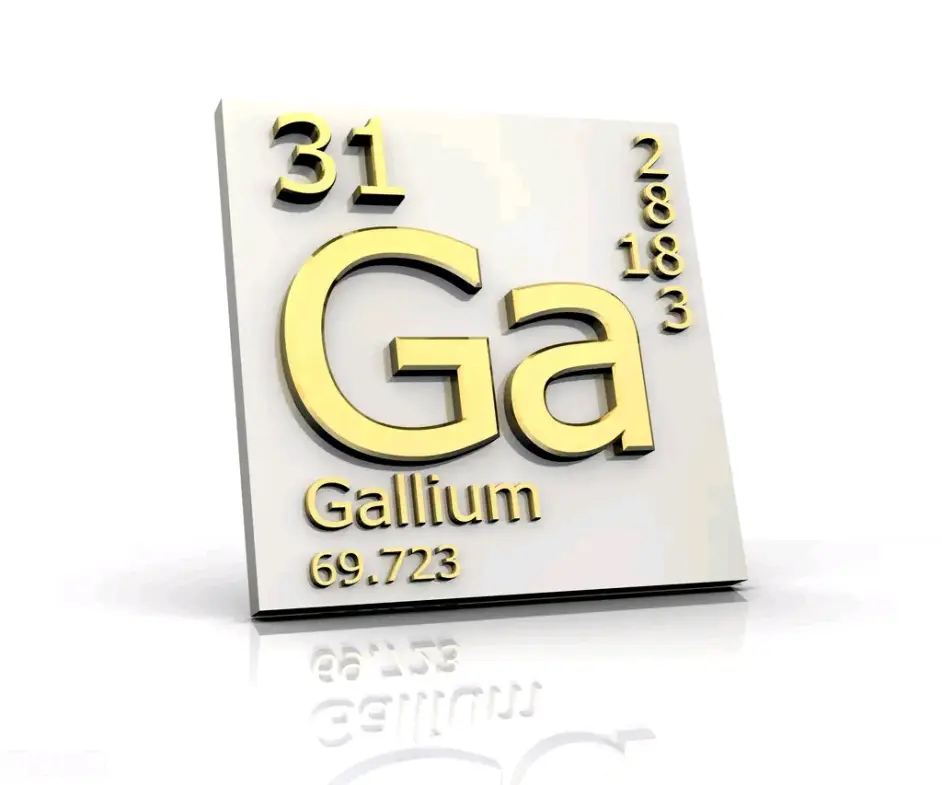

众所周知,作为“工业维生素”,稀土是一种重要的战略金属资源,没了它,很多高科技产品都玩不转。而有一种战略金属资源,同样在高科技领域中应用广泛,也是芯片制造的关键材料。这种资源与稀土一样,都是我国的优势矿种,储量和产量全球第一。那么,到底是哪种战略金属资源?这就是接下来为各位介绍的金属镓。

镓是一种银白色的稀有金属,它的熔点很低,是自然界中少有的在常温下呈液体的金属。由于它在地壳中含量稀少,分布又比较分散,所以没有独立的矿床,主要与铝、锌、锗等矿物伴生,比较难提取。要知道,2020年全球粗镓产量也不过是300吨,其中,中国的产量就高达290吨,占全球产量的96%以上,其它的粗镓产国连中国的零头都不到。
不止是产量,中国的金属镓储量同样是全球第一。根据美国地质调查局(USGS)公布的数据,目前全球金属镓的储量约为27.93万吨,而中国的储量最多,达到19万吨,占全球储量的68%左右;相比之下,美国的储量还不到中国的1/40,只有0.45万吨。可见,与稀土一样,金属镓也是我国手中的一张王牌。
那么,这种金属资源到底有什么用?首先,它是芯片制造的关键材料。提到半导体材料,各位可能会想到碳化硅,但或许不知道氮化镓,它们都是第三代半导体的关键材料。相比硅材料,氮化镓的禁带宽度、电子饱和迁移速度和击穿场强都更胜一筹,这些优点使其在射频器件和电力电子器件的制造上更有优势。

比如近年来大家广泛关注的5G技术,它所使用的高频无线电波脉冲芯片组,就是用氮化镓来制造的,并且这种材料耗电少、发热少,还能够在800摄氏度的高温下工作,相比碳化硅,成本也相对低一点。
其实,除了在半导体领域得到“重用”之外,金属镓以及它的一系列化合物已经广泛应用于新能源汽车、LED照明、太阳能电池以及雷达等众多领域,它的很多用途与当前的绿色能源和低碳经济息息相关。
这些年来,节能减排日益受到全球各国的关注,《巴黎协定》还致力于推动各国制定并落实减排任务。可以预想,未来全球对镓的消费需求会越来越大,这种资源在日后也会更“大有可为”。

正因为意识到它的重要性,而且自身储量不多,欧美、日本等国家早就对镓资源进行管控和储备,比如欧盟在2010年发布的14种矿产原料紧缺名单中,镓就位列其中;美国在2018年也将镓列入35种关键矿产清单中。
然而,日本是全球镓第一大消费市场,美国则紧随其后,欧盟也是重要的镓消费市场,它们自己的镓资源没怎么开发,那么就需要依赖进口了,这其中很大一部分镓就进口自中国。

其实刚也提到,中国的粗镓产量已占到了全球的96%以上,有分析指出,可能也是由于中国的产量大,甚至出现产能过剩,抑制了其它国家的生产。过去几年,哈萨克斯坦、匈牙利、德国和乌克兰等国已先后停止了初级镓的生产,所以我们才会看到,全球粗镓产能几乎被中国垄断。
当然,欧美日等发达国家用到的镓资源并非100%从中国进口。随着镓回收利用技术的不断发展,如今,全球再生镓的产量已经不低了,2020年的产量便达到250吨,并且还呈现逐步上升的趋势,未来甚至不排除会超过粗镓的产量。
所以,欧美等发达国家也有一部分的镓供应来自这些再生镓,尤其是回收产业发展最好的日本,已经有一半的镓供应来自本国的回收产业,逐渐摆脱对中国的依赖。
这些年来,我国新能源汽车、光伏、LED照明等产业迅速发展,也带动了镓以及它的化合物等消费量迅速增长,但不完美的地方在于,我国半导体等产业的发展还落后于美日韩等发达国家,因此,我国的高端精镓产品(高端电子元件)也仍高度依赖进口,这从芯片成为我国第一大进口商品便可以窥探一二。

值得注意的是,近年来,为了解决芯片“卡脖子”等难题,我国已经开始大力发展芯片产业,并提出到2025年将芯片自给率提升到70%的目标。可以见得,接下来国产芯将加速崛起,未来我国的高精镓产品对外依赖也会逐渐降低。
另外,作为我国的一种优势矿种,与欧美国家一样,我国也早就对镓资源进行了相关的管控。比如2011年,我国便将镓列入战略储备金属,计划在适当的时候对它进行收储。随着镓资源重要性日益提升,相信我国还会对这种战略资源进行相关的保护。
As we all know, as an "industrial vitamin", rare earth is an important strategic metal resource. Without it, many high-tech products can't play. There is a strategic metal resource, which is also widely used in the high-tech field and is also the key material for chip manufacturing. Like rare earth, this resource is the dominant mineral in China, with the largest reserves and output in the world. So, what kind of strategic metal resources? This is the metal gallium introduced to you next.
Metal gallium, the key material for chip manufacturing! China has the largest reserves in the world, and Europe and the United States also need to import a large amount
Gallium is a silver white rare metal with a low melting point. It is a rare metal in nature that is liquid at room temperature. Because its content in the earth's crust is rare and its distribution is relatively scattered, there is no independent deposit. It is mainly associated with minerals such as aluminum, zinc and germanium, which is difficult to extract. You know, the global output of crude gallium in 2020 is only 300 tons, of which China's output is as high as 290 tons, accounting for more than 96% of the global output, and other crude gallium producing countries are less than a fraction of China.
Not only the output, China's metal gallium reserves are also the first in the world. According to the data released by the United States Geological Survey (USGS), the global reserves of metal gallium are about 279300 tons, while China has the largest reserves, reaching 190000 tons, accounting for about 68% of the global reserves; In contrast, the reserves of the United States are less than 1 / 40 of that of China, only 4500 tons. It can be seen that, like rare earth, metal gallium is also a trump card in China's hands.
So, what is the use of this metal resource? First, it is the key material for chip manufacturing. When it comes to semiconductor materials, you may think of silicon carbide, but you may not know gallium nitride. They are the key materials of the third generation of semiconductors. Compared with silicon materials, gallium nitride has better band gap width, electron saturation migration velocity and breakdown field strength. These advantages make it more advantageous in the manufacture of RF devices and power electronic devices.
Metal gallium, the key material for chip manufacturing! China has the largest reserves in the world, and Europe and the United States also need to import a large amount
For example, 5g technology, which has attracted much attention in recent years, uses high-frequency radio wave pulse chipsets made of gallium nitride. This material consumes less power and generates less heat. It can also work at a high temperature of 800 degrees Celsius. Compared with silicon carbide, the cost is also relatively low.
In fact, in addition to being "reused" in the semiconductor field, metal gallium and a series of its compounds have been widely used in many fields such as new energy vehicles, LED lighting, solar cells and radar. Many of its uses are related to the current green energy and low-carbon economy.
In recent years, energy conservation and emission reduction have attracted increasing attention from countries around the world. The Paris Agreement is also committed to promoting countries to formulate and implement emission reduction tasks. It can be expected that the global consumption demand for gallium will be greater and greater in the future, and this resource will be more "promising" in the future.
Metal gallium, the key material for chip manufacturing! China has the largest reserves in the world, and Europe and the United States also need to import a large amount
Aware of its importance and its small reserves, countries such as Europe, America and Japan have long controlled and reserved gallium resources. For example, gallium is one of the 14 mineral raw material shortage lists released by the European Union in 2010; The United States also included gallium in the list of 35 key minerals in 2018.
However, Japan is the largest gallium consumption market in the world, followed by the United States, and the European Union is also an important gallium consumption market. If their own gallium resources are not developed, they need to rely on imports, and a large part of gallium is imported from China.
Metal gallium, the key material for chip manufacturing! China has the largest reserves in the world, and Europe and the United States also need to import a large amount
In fact, it was just mentioned that China's crude gallium production has accounted for more than 96% of the world. Some analysts pointed out that it may also be due to China's large production and even overcapacity, which has restrained the production of other countries. In the past few years, Kazakhstan, Hungary, Germany, Ukraine and other countries have successively stopped the production of primary gallium, so we can see that the global crude gallium production capacity is almost monopolized by China.
Of course, not 100% of gallium resources used by developed countries such as Europe, America and Japan are imported from China. With the continuous development of gallium recycling technology, the global output of regenerated gallium is not low now. The output will reach 250 tons in 2020, and it also shows a gradual upward trend. In the future, it will even exceed the output of crude gallium.
Therefore, some of the gallium supply in developed countries such as Europe and the United States comes from these regenerated gallium, especially Japan, which has the best development of recycling industry. Half of the gallium supply comes from its own recycling industry, gradually getting rid of its dependence on China.
In recent years, China's new energy automobile, photovoltaic, LED lighting and other industries have developed rapidly, which has also driven the rapid growth of gallium and its compounds. However, the imperfection is that the development of China's semiconductor and other industries still lags behind developed countries such as the United States, Japan and South Korea. Therefore, China's high-end refined gallium products (high-end electronic components) are still highly dependent on imports, This can be seen from the fact that the chip has become the largest imported commodity in China.
Metal gallium, the key material for chip manufacturing! China has the largest reserves in the world, and Europe and the United States also need to import a large amount
It is worth noting that in recent years, in order to solve the problems such as chip "neck", China has begun to vigorously develop the chip industry and put forward the goal of raising the chip self-sufficiency rate to 70% by 2025. It can be seen that the rise of domestic cores will accelerate next, and China's foreign dependence on high-precision gallium products will gradually decrease in the future.
In addition, as an advantageous mineral in China, like European and American countries, China has long controlled gallium resources. For example, in 2011, China listed gallium as a strategic reserve metal and planned to collect and store it at an appropriate time. With the increasing importance of gallium resources, it is believed that China will protect such strategic resources.
